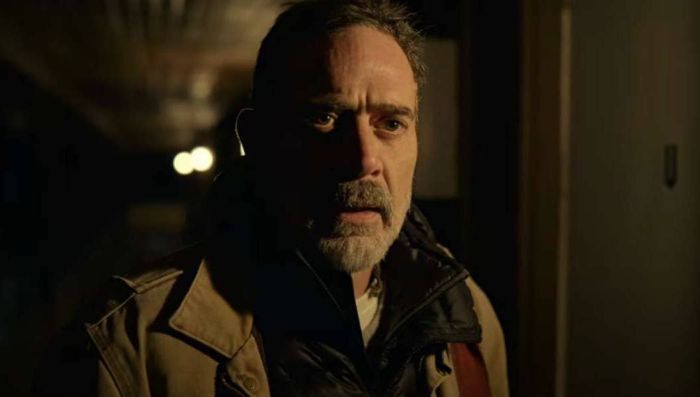A voice from heaven
And this story could happen to anyone. Here’s where Gerry Fenn (Jeffrey Dean Morgan) comes to the sleepy town of Banfield. The journalist is to investigate the matter of marks appearing on the bodies of cows – allegedly out of nowhere and / or in mysterious circumstances. An experienced editor quickly realizes that he will not twist a whip out of this pie, so when he finds a strange-looking doll near the pasture, he decides to pull the ace out of its sleeve and twist the source material a bit. Soon after, an amazing event occurs in the town – a voice speaks to the deaf-mute teenager, which she herself interprets as a message from Mary. The revelation heals the girl, who from then on – as a messenger of a supernatural being – begins to heal herself, which attracts the local community and draws the attention of high hierarchs of the Church and world media. Bishop Gyles (Cary Elwes) will do anything to make the place of alleged miracles a shrine like Fatima and Lourdes, while Father Delgarde (Diogo Morgado), an envoy from the Holy See, will try to undermine these events. Only Father Hagan (William Sadler) – the parish priest of a small parish, and at the same time the guardian of a haunted girl, is skeptical about “divine” events, warning against unclean forces, always lurking for lost sheep.

Source: rogersmovienation.com
Schrödinger God
When asked for a list of ten books everyone should read, Neil deGrasse Tyson put the Bible first. The reasoning was: “… to see that it is easier to tell others what to think and believe than to think for yourself.” Up to a point, the The Unholy also seems to be held in a similar vein. The main character, a non-practicing Catholic, and at the same time a dilapidated journalist, longingly recalling the times of splendor marked by luxury and prestige, appears here as a model skeptic, aware of the mechanisms and strategies of manipulation used by speakers who want to maintain attention and faith, the metaphorical “government souls “. At the same time, his professional acumen does not allow him to leave the case after only a cursory examination. This distance, combined with the not necessarily glorious reputation he has earned over the years of low-profile practices, will prove to be crucial at the climax, when blind fanaticism tries to overcome by appeal to common sense and self-reflection. Sounds good, right? Well, disappointment comes shortly after, when a sudden epiphany reverses the current order, smashing the Word of God written in golden letters on the head.God is not dead .
These feelings are heightened by the tone of the story. The Unholy lacks any distance or irony. Fenn, at the beginning of his journey, throws a few sarcastic jokes, but the whole thing takes himself very seriously. Visualized in full literal revelation and the faces appearing in this rainbow on the horizon, juxtaposed with the unwavering gravity of the narrative, produce an unintended comic effect, and therefore, I believe, the exact opposite of the original assumption …

Source: flickeringmyth.com
False advertising , or “ladies, that’s not how we agreed”
It should be signaled immediately that The Unholy is a complete failure as a genre horror. From the first to the last minute, the picture is predictable and devoid of even a hint of tension (no wonder, as the great twist of the plot is revealed before the actual setting of the plot, already in the first minutes of the film, when the angry crowd decides to murder the camera operator.a certain woman). The atmosphere of horror is to be built up by strange formal measures, such as instantaneous distortion of perspective and tricks such as “something wants to hurt the operator”. These, however, instead of building a sense of confusion, they reveal the artificiality of film matter, simply not allowing you to be immersed. Similar tricks, with much greater success, have been used many times by other artists; The camera flowing in various unnatural directions is a hallmark of Gaspar Noé’s works, while the threat slowly approaching the lens can be found, for example, in the already iconic Hideo Nakata’s Ring and a quite successful American remake from 2002. In the case of The Unholy the horror is based entirely on the (poorly) computer-generated pop-up mouths, reduced to the flash scarecrow level.
However, I see a certain untapped potential in the socio-philosophical aspect of the film. Repeated inclusions about the tourist and commercial value of the largest Marian sanctuaries (and thus also other sacred buildings and places of worship) are an excellent starting point for sociological and theological considerations about the façade and macdonaldization of faith, the mechanisms of persuasion and propaganda (in extreme cases taking the form of brainwashing), ideological blindness or corruption in hierarchical power structures. The director himself, who is also the main screenwriter of the film, at times seems to question the sense of an institutionalized cult, personified in the form of a fierce bishop, through the eyes of the imagination already counting the dollars flowing to the future sanctuary from the wallets of the faithful from around the world, and reinforced with prints inserted from time to time depicting crowds gathering in similar places. The film could gain a lot if, instead of trying to frighten it, it tried to expand this plot. Well, it called somewhere, but probably not in this church.
We would like to thank the Cinema City chain for the opportunity to watch the film!

